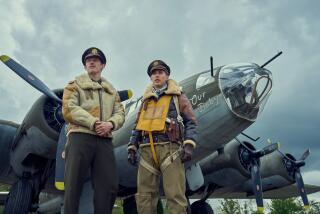Flight Plan
- Share via
A century ago, man couldn’t fly. Now, people take flight for granted. But man’s ability to fly was earned through the blood, sweat, tears and deaths of pioneers and visionaries. A new four-part series produced by KCET/Hollywood, “Chasing the Sun,” celebrates these buccaneers of the sky.
“We don’t think of these incredible people who were risking their lives every time they got into a plane,” says Carl Byker, executive producer-writer and director of “Chasing the Sun.”
“After you are done watching all four shows, you should feel: ‘Wow, it’s really special to fly,’ ” says Byker. “We should remember all of the people who made it possible.”
Byker’s partner, director-cinematographer Mitch Wilson, learned that KCET was planning to make a documentary on aviation and convinced Byker they should make “Chasing the Sun.”
Wilson had grown up around the airline industry. “My dad was a production planner in maintenance in Tulsa for American Airlines for 45 years,” explains Wilson, who, with Byker, produced and directed the Emmy Award-winning documentary series “The Great War and the Shaping of the 20th Century.”
“I had model airplanes hanging from the ceiling, and I just loved airplanes,” adds Wilson. “It was one of those assignments that I couldn’t wait to do. We got to fly in some really cool stuff.”
Byker also enjoyed flying in vintage airplanes like the Constellation, a.k.a. the “Connie,” that was designed by the Lockheed Company for Howard Hughes.
The best experience was flying in an old Ford Trimotor. “Those old planes flew so low, you had such an incredible view,” says Byker. “You were flying at, like, 1,000 feet in the air on this stately plane. It was almost like being on a train in the air. But if you suddenly hit turbulence, it was a nightmare.”
“Chasing the Sun” looks at such well-known names in aviation history as Orville and Wilbur Wright, the bicycle mechanics who became the first to fly a plane in 1903, as well as Charles Lindbergh, who made the first solo nonstop flight cross the Atlantic. But it also showcases such unsung heroes as Harriet Quimby, the first American woman to get her pilot’s license.
A photojournalist and world traveler, Quimby realized money could be made on the air-show circuit. Wearing her trademark purple flying suit, she became one of its most popular performers in 1911. And in 1912 she became the first woman to cross the English Channel. But only three months after this feat, Quimby was thrown from her airplane and killed at an air show. A reporter for the Boston Globe wrote of Quimby: “She took her chances like a man, and died like one.”
Then there’s the tragic story of Frank Whittle, a working-class officer in the British Royal Air Force, who discovered the jet engine in 1937. When his company was nationalized, however, Rolls-Royce and De Havilland convinced the British government that they should be the only ones to make the jet engine. Whittle was pushed aside and ultimately suffered a nervous breakdown.
“The Frank Whittle thing was so sad,” says Wilson. “He is this common guy who had this great idea. ... Then it got to the point when they didn’t think he was smart enough to keep [his company] going and they took it away from him.”
Airline stewardesses are also singled out for their importance in aviation history. The airline stewardess was the brainchild of a young nurse named Ellen Church who, in 1930, went to Boeing Air Transport, a parent company of United Airlines, to suggest that the company put nurses aboard planes to care for sick and frightened passengers. But it was a dangerous profession--about 11 stewardesses lost their lives in plane crashes in the ‘30s.
“The whole point was to make men more comfortable flying,” says Byker. “It was a tough job. For most of them, it was the first job they ever had, and they were, all of a sudden, confronted with really intense situations, and they delivered the goods.”
* “Chasing the Sun” airs July 2, 9, 16 and 23 at 9 p.m. on KCET and KVCR. The network has rated it TV-G (suitable for all ages).
More to Read
Sign up for The Wild
We’ll help you find the best places to hike, bike and run, as well as the perfect silent spots for meditation and yoga.
You may occasionally receive promotional content from the Los Angeles Times.







